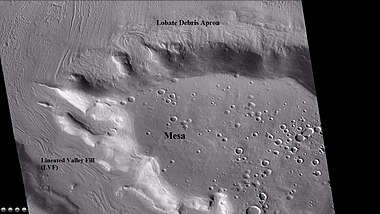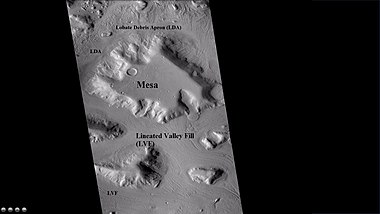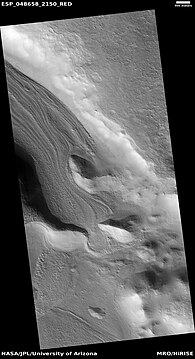Lineated valley fill (LVF), also called lineated floor deposit, is a feature of the floors of some channels on Mars, exhibiting ridges and grooves that seem to flow around obstacles. Shadow measurements show that at least some of the ridges are several metres high. LVF is believed to be ice-rich.[1][2] Hundreds of metres of ice probably lie protected in LVF under a thin layer of debris.[3][4][5] The debris consists of wind-borne dust, material from alcove walls, and lag material remaining after ice sublimated (changed from a solid directly to a gas) from a rock-ice mixture. Some glaciers on Earth show similar ridges. High-resolution pictures taken with HiRISE reveal that some of the surfaces of lineated valley fill are covered with strange patterns called closed-cell and open-cell brain terrain. The terrain resembles a human brain. It is believed to be caused by cracks in the surface accumulating dust and other debris, together with ice sublimating from some of the surfaces. The cracks are the result stress from gravity and seasonal heating and cooling.[6][7] This same type of surface is present on Lobate debris aprons and Concentric crater fill so all three are believed to be related.
-
Wide CTX view of mesa showing lineated valley fill and lobate debris apron (LDA). Both are believed to be debris-covered glaciers. Location is Ismenius Lacus quadrangle.
-
Close-up of lobate debris apron from the previous CTX image of a mesa. Image shows open-cell brain terrain and closed-cell brain terrain, which is more common. Open-cell brain terrain is thought to hold a core of ice. Image is from HiRISE under HiWish program.
-
Closed-cell brain terrain, as seen by HiRISE under the HiWish program. This type of surface is common on lobate debris aprons, concentric crater fill, and lineated valley fill.
-
Open- and closed-cell brain terrain, as seen by HiRISE, under HiWish program.
-
Wide CTX view showing mesa and buttes with lobate debris aprons and lineated valley fill around them. Location is Ismenius Lacus quadrangle.
-
Close-up of lineated valley fill (LVF), as seen by HiRISE under HiWish program. Note: this is an enlargement of the previous CTX image.
-
Lineated valley fill, as seen by HiRISE under HiWish program.
-
Close view of Lineated valley fill, as seen by HiRISE under HiWish program
-
Close, color view of Lineated valley fill, as seen by HiRISE under HiWish program
-
Valley showing Lineated valley fill, as seen by HiRISE under HiWish program Linear valley flow is caused by ice movements. Location is Casius quadrangle.
-
Lineated valley fill in valley, as seen by HiRISE under HiWish program Linear valley flow is ice covered by debris. Location is Ismenius Lacus quadrangle.
-
Close, color view of lineated valley fill, as seen by HiRISE under HiWish program
-
Lineated valley fill, as seen by HiRISE under HiWish program Image located in Hellas quadrangle.
Lineated floor deposits began as lobate debris aprons (LDAs), which form as material leaves narrow mountain valleys and spreads out as an apron.[8] By tracing the paths of the ridges on LDAs, researchers have come to believe that the curved ridges characteristic of lobate debris aprons straighten out to form the more or less straight ridges of LVF.[5][9][10][11]
In the regions where LVF and LDAs occur, many craters have concentric crater fill: large ridges and other surfaces nicknamed brain terrain, after the surface corrugations of the human brain.[12]
The study of lineated valley fill and other features related to debris-covered ice has been greatly aided by the abundance of data received from Mars orbiting instruments. Excellent images have been obtained from THEMIS, MOC, CTX, and HiRISE. Detailed altimetry was collected by MOLA.
The Mars Reconnaissance Orbiter's Shallow Radar gave a strong reflection from the top and base of LDAs, meaning that pure water ice made up the bulk of the formation (between the two reflections), strong evidence that the LDAs in Hellas Planitia are glaciers covered with a thin layer of rocks. Since lineated valley terrain is derived from lobate debris aprons, it probably contains buried ice—at least in places.[8][13][14]
- ^ Cite error: The named reference
obliqwas invoked but never defined (see the help page). - ^ Head, J., et al. 2006. Modification if the dichotomy boundary on Mars by Amazonian mid-latitude regional glaciation. Geophys. Res. Lett. 33
- ^ Morgan, G.; Head, James W.; Marchant, David R. (2009). "Lineated valley fill (LVF) and lobate debris aprons (LDA) in the Deuteronilus Mensae northern dichotomy boundary region, Mars: constraints on the extent, age, and episodicity of Amazonian glacial events". Icarus. 202 (1): 22–38. Bibcode:2009Icar..202...22M. doi:10.1016/j.icarus.2009.02.017.
- ^ Head, J. and D. Marchant. 2006. Evidence for global-scale northern mid-latitude glaciation in the Amazonian period of Mars: Debris-covered glacial and valley glacial deposits in the 30 - 50 N latitude band. Lunar. Planet. Sci. 37. Abstract 1127
- ^ a b Head, J. & D. Marchant (2006). "Modification of the walls of a Noachian crater in northern Arabia Terra (24E, 39N) during mid-latitude Amazonian glacial epochs on Mars: Nature and evolution of lobate debris aprons and their relationships to lineated valley fill and glacial systems". Lunar Planet. Sci. 37: Abstract # 1126.
- ^ Mellon, M. 1997. Small-scale polygonal features on Mars: Seasonal thermal contraction cracks in permafrost. J. Geophysical Res: 102. 25,617-625,628.
- ^ Ley, J. et al. 2009. Concentric crater fill in Utopia Planitia: History and interaction between glacial "brain terrain" and periglacial processes. Icarus: 202. 462-476.
- ^ a b Souness C., Hubbard B. (2013). "An alternative interpretation of late Amazonian ice flow: Protonilus Mensae, Mars". Icarus. 225 (1): 495–505. Bibcode:2013Icar..225..495S. doi:10.1016/j.icarus.2013.03.030.
- ^ Kress, A., J. Head (2008). "Ring-mold craters in lineated valley fill and lobate debris aprons on Mars: Evidence for subsurface glacial ice". Geophys. Res. Lett. 35 (23): L23206–8. Bibcode:2008GeoRL..3523206K. doi:10.1029/2008gl035501.
{{cite journal}}: CS1 maint: multiple names: authors list (link) - ^ Baker, D.; Head, James W.; Marchant, David R. (2010). "Flow patterns of lobate debris aprons and lineated valley fill north of Ismeniae Fossae, Mars: Evidence for extensive mid-latitude glaciation in the Late Amazonian". Icarus. 207 (1): 186–209. Bibcode:2010Icar..207..186B. doi:10.1016/j.icarus.2009.11.017.
- ^ Kress., A. & J. Head (2009). "Ring-mould craters on lineated valley fill, lobate debris aprons, and concentric crater fill on Mars: Implications for near-surface structure, composition, and age". Lunar Planet. Sci. 40: abstract 1379.
- ^ Levy, J.; Head, James W.; Marchant, David R. (2009). "Concentric crater fill in Utopia Planitia: History and interaction between glacial "brain terrain" and periglacial processes". Icarus. 202 (2): 462–476. Bibcode:2009Icar..202..462L. doi:10.1016/j.icarus.2009.02.018.
- ^ Plaut, J. et al. 2008. Radar Evidence for Ice in Lobate Debris Aprons in the Mid-Northern Latitudes of Mars. Lunar and Planetary Science XXXIX. 2290.pdf
- ^ Head, JW; Neukum, G; Jaumann, R; Hiesinger, H; Hauber, E; Carr, M; Masson, P; Foing, B; et al. (2005). "Tropical to mid-latitude snow and ice accumulation, flow and glaciation on Mars". Nature. 434 (7031): 346–350. Bibcode:2005Natur.434..346H. doi:10.1038/nature03359. PMID 15772652. S2CID 4363630.












